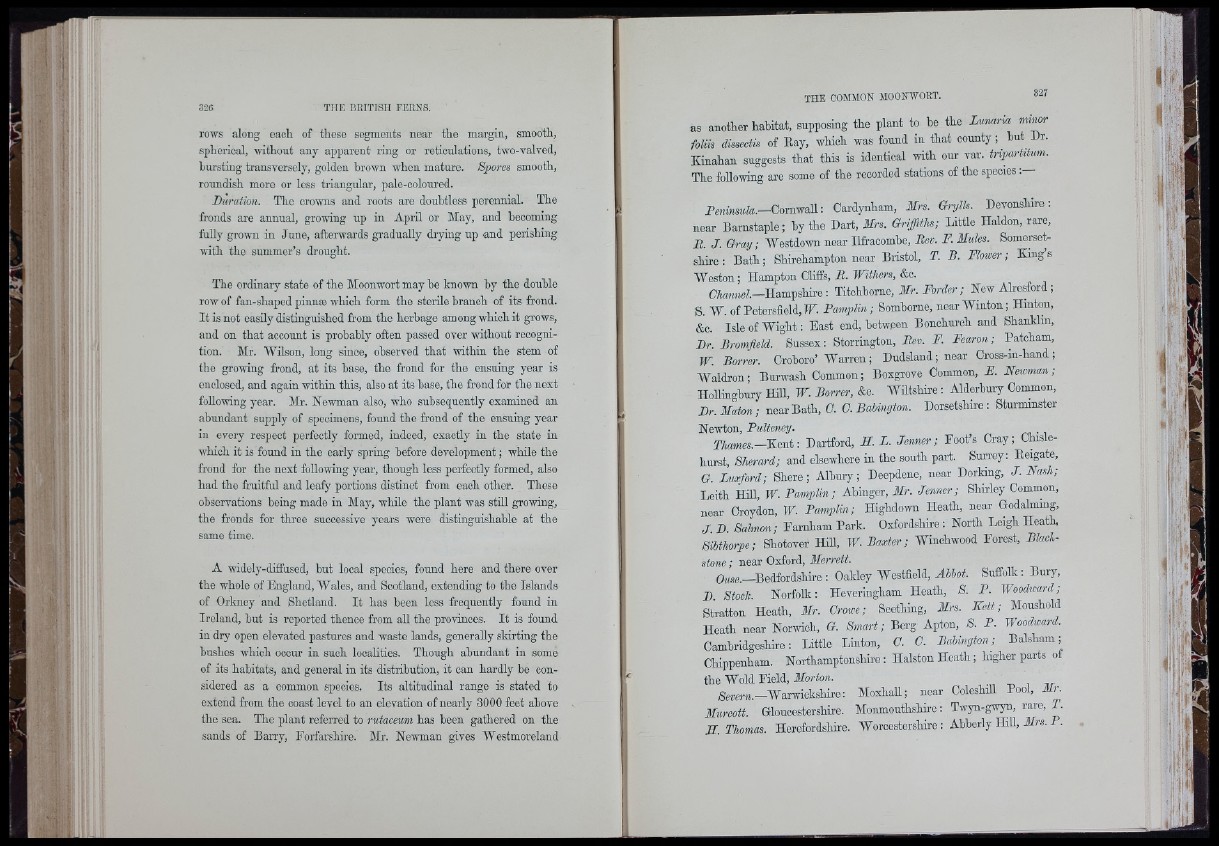
ir
li" ¥
. ■?
7 i;
11 '
ri : '
U i1
rows along each of those segments near the margin, smooth,
spherical, without any apparent ring or reticulations, two-valvcd,
bursting transversely, golden brown when mature. Sjiores smooth,
roundish more or loss triangular, pale-coloured.
Duration. The crowns and roots are doubtless perennial. The
fronds are annual, growing up in April or May, and becoming
fully grown in June, afterwards gradually drying up -and perishing
with tho summer’s drought.
Tho ordinary state of tho Moonwort may bo known hy the double
row of fan-shaped pinnæ which form the sterile branch of its frond.
It is not easily distinguished from the herbage among which it grows,
and on that accomit is probably often passed over without recognition.
Mr. Wilson, long since, observed that within the stem of
tho growing frond, at its base, the frond for the ensuing year is
enclosed, and again within this, also at its base, the frond for the next
following year. Mi’. Newman also, who subsequently examined an
abundant supply of specimens, found tho frond of the ensuing year
in every respect perfectly formed, indeed, exactly in the state in
which it is found in the early spring before development ; while the
frond for the next foUowing year, though less perfectly formed, also
had tho fruitful and leafy portions distinot from each other. These
observations being made in May, while the plant was stiU growing,
the fronds for three successive years were distinguishahle at the
same time.
A widely-diffused, hut local species, found here and there over
the whole of England, Wales, and Scotland, extending to the Islands
of Orkney and Shetland. It has been less frequently fonnd in
Ireland, hut is reported thence from aU the provinces. It is found
in dry open elevated pastures and waste lands, generaUy skirting the
bushes which occur in such localities. Though abundant in some
of its habitats, and general in its distribution, it can hardly be considered
as a common species. Its altitudinal range is stated to
extend from the coast level to an elevation of nearly 3000 feet above
the sea. The plant referred to rutaceum has been gathered on the
sands of Barry, Forfarshire. Mr. Newman gives Westmoreland
It
as another habitat, supposing the plant to he the Lunaria mirwr
foliis dissectis of Eay, which was found in that county ; but Dr.
Kinahan suggests that this is identical with our var. triparUum.
The foUowing are some of tho recorded stations of the species;
Peninsula.— Conxwall: Cardynham, Mrs. Grylls. Devonshire:
near Barnstaple; by the Dart, Mrs. Griffiths; Little Haldon, rare,
B. J. Gray; Westdown near Ilfraoombe, Bev. F. Mules. Somersetshire
: Bath; Shirehampton near Bristol, T. B. Flower; King s
Weston; Hampton Cliffs, B. Withers, &c.
O/iamiel.—Hampshire: Titohborno, Mr. Border; New Alrerford;
S. W. of Petersfield, IT. Pamplin; Somborne, nearWinton; Ilinton,
&o. Isle of Wight: East end, botw.een Bonohurch and Shanldin,
Dr. Bromfleld. Sussex: Storrington, Bev. F. Fearon; Patcham,
W. Borrer. Croboro’ Warren; Hudsland; near Cross-in-hand;
Waldron; Burwash Common; Boxgrove Common, E. Newman;
HoUingbury HiU, W. Borrer, &o. WUtshire: Alderbury Common,
Br. Maton; near Bath, G. C. Bahington. Borsetshire: Sturminster
Newton, Fulteney. .
Thames.-K.eMe-. Dartford, H. L. Jenner; Foot’s Cray; Chisle-
hurst, Sherard; and elsewhere in the south part. Surrey: Eeigate,
G. Luxford; Shore ; Albury; Doepdene, near Dorking, J. Nash;
Leith HiU, W. Pamplin; Ahingor, Mr. Jenner; Shirley Common,
near Croydon, W. Pamplin; Highdown Heath, near Godalming,
J B. Salmon; Farnham Park. Oxfordshire: North Leigh Heath,
SiUhorpe; Shotover HiU, W. Baxter; Winchwood Forest, Blaclstone;
near Oxford, Merrett.
Oiise.—Bedfordshire : Oakley Westfield, Ahhot. Suffolk: Bury,
B. Stock. Norfolk: Hevcringham Heath, S. F. Woodward;
Stratton Heath, Mr. Crowe; Seething, Mrs. K e tt; Moushold
Heath near Nonrioh, G. Smart; Berg Apton, S. P. Woodward.
Cambridgeshire: Little Linton, C. C. BaUngton; Balsham;
Chippenham. Northamptonshire: Halston Heath; higher parts o
tlie Wold Field, Morton. ^ n i
Warwickshire: MoxhaU; near ColeshiU Pool, Mr.
Murcott. Gloucestershire. Monmouthshire: Twyn-gwyn, rare, T.
JI. Thomas. Herefordshire. Worcestershire: Abhorly Hill, J/rs. P.
iFr ij' .*111
i ‘
'Iti
1 I • 'fT
i .yt
1
-I »
■ t t
‘I
il
ii I
. m